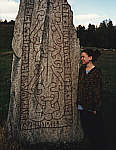|
|
Rune Stones:
Rune stones are erected and high stones, which stand vacantly and are supplied with rune signs. They are cognate to the picture stones (stones with decoration, mostly with a motive from the nordic myths) or also to the bauta stones (raw and without any epigraph). During the times of the migration of nations or the vikings rune stones often were being erected as a memory for people, who had died in a battle.
The runes themselves are germanical letters, which originally were being scratched into wood, but later also into stone, ivory and others. They were being used nearly exclusively for epigraphs. The older rune alphabet (which is also called "Futhark") consisted out of 24 letters, later then in Scandinavia it got shortened to 16 letters by simplification.
|
|

 Close to Anundshög near Västerås with
it's ship settings (see "Settings") stands a big rune stone. It's hight might
be estimated by a look at the photo on the right. It stands in a range with
smaller, set stones, but a little more in the front. This range of stones
has probably lined the old path, which has been a part of "Eriksgata", which
means part of the way, the new king took on horseback in order to inspect
his empire or to show himself to his people. The rune stone was erected during
the first half of the 11th century and bears the inscription: "Folkvid erected
all these stones in honour of his son Heden, the brother of Anund. Vred carved
the runes."
Close to Anundshög near Västerås with
it's ship settings (see "Settings") stands a big rune stone. It's hight might
be estimated by a look at the photo on the right. It stands in a range with
smaller, set stones, but a little more in the front. This range of stones
has probably lined the old path, which has been a part of "Eriksgata", which
means part of the way, the new king took on horseback in order to inspect
his empire or to show himself to his people. The rune stone was erected during
the first half of the 11th century and bears the inscription: "Folkvid erected
all these stones in honour of his son Heden, the brother of Anund. Vred carved
the runes."

 On both sides of the old country road between Västerås
and Köping stands this pair of rune stones from lightbrown stone, which
had been laying fallen down for a long time. They are from the viking age.
The smaller one of the two stones (right picture, unfortunately not easily
to see because of the position of the sun) shows an animal with long and
stretched neck, which reminds to a swan. Into the other stone there has been
carved a cross, which is surrounded by a round inscription: "Gisl has caused
to make this stone as a reminder of Ösel, his son. He died in England.
God may help his spirit and his soul."
On both sides of the old country road between Västerås
and Köping stands this pair of rune stones from lightbrown stone, which
had been laying fallen down for a long time. They are from the viking age.
The smaller one of the two stones (right picture, unfortunately not easily
to see because of the position of the sun) shows an animal with long and
stretched neck, which reminds to a swan. Into the other stone there has been
carved a cross, which is surrounded by a round inscription: "Gisl has caused
to make this stone as a reminder of Ösel, his son. He died in England.
God may help his spirit and his soul."
©Angelika Friedrich, Jan. 2000
http://www.schwedenecke.de/